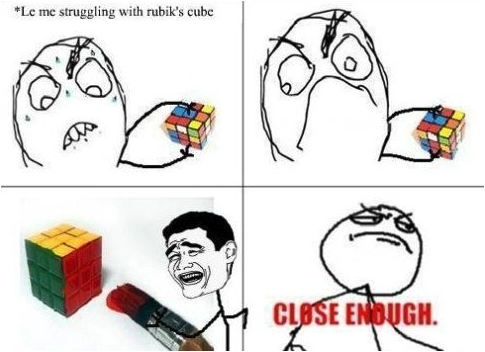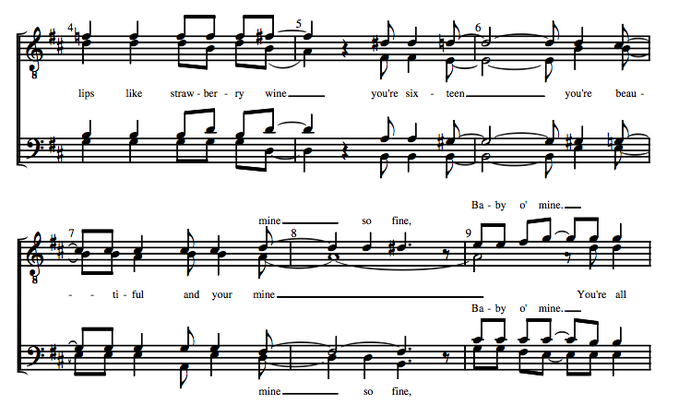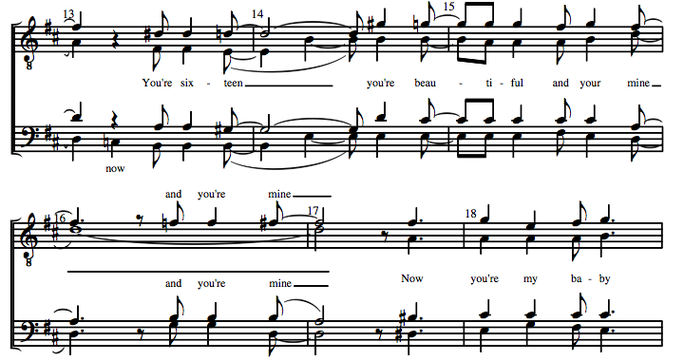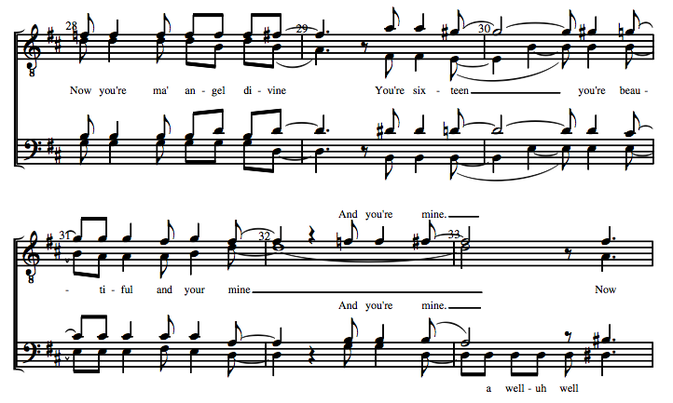Though difficult to always notate, or eventually perform successfully, when desiring to notate passages to sound polyphonic or just more rhythmically interesting and diverse, for whatever reason, you must strive to arrange the musical elements with a potential culminating performance in mind; where the performer delivers the song with a feeling that it contains primarily four-part homo-rhythmic consonant chords.
|
I woke one night and had this in my head so had to write it down... pretty formal/geeky, but sums up my approach to some extent!
Though difficult to always notate, or eventually perform successfully, when desiring to notate passages to sound polyphonic or just more rhythmically interesting and diverse, for whatever reason, you must strive to arrange the musical elements with a potential culminating performance in mind; where the performer delivers the song with a feeling that it contains primarily four-part homo-rhythmic consonant chords.
1 Comment
WARNING: Barbershop / acappella talk dead ahead. Take detour to avoid geeked-out music chatter. I just changed our furnace filter, and it was disgusting - no wonder my allergies in Kentucky are horrible! But it spurred thoughts on other filters I use - in my arrangements. Sometimes I purposefully think through this filter concept, and other times it just happens naturally. It's like knowing the algorithms and patterns for solving a rubiks cube. Have you ever gone through that learning process? Really works your memorization skills! My 13 yr-old son is all in to it right now - solving 3-sided, 4-sided, and wants to try anything new possible. So he's taught me the patterns, and I'm slowly getting it - memorizing everything. For me, I have to take my time and go through every step and turn and pattern carefully... feeling very stupid along the way - while my son solves it in a minute because it's all second nature to him. He's to a point where he doesn't think about anything and he just looks at it and solves it - plus he's just way smarter than his dad in most areas! It's a poor analogy, but perhaps the process of solving that stupid cube is like the arranging process I go through. I know what I need to do, but sometimes I have to think through it carefully, while other times it just goes smoothly and things fall into place naturally. So, when starting to work on a new composition/arrangement project, there are some things I have to find out and plan out ahead of time - based on what the group wants. When I first started doing commissioned work for groups, I just wanted to make sure I didn't screw up the song for them - that alone motivated me to find out everything possible I could about the group before writing. It was great motivation for making the arrangement good... or not suck... however you want to put it. I'm sure all of you find out certain important things up front... as every song and group is different and they might want song to fill a certain need compared to other songs in their repertoire. I guess at first when discussing the arrangement with the group, that's when the big filters are used. That's when we decide things like...
Once I get through portions of the song I can go back through and sift those sections through small or big filters.... then again once the whole song is finished. The idea of using "filters" may be too formal for some people… And I certainly don't always think this formally about it. But it's a good way of voicing or writing down the thought process. I already mentioned a few, but here is totally unorganized and uncategorized list of more questions and filters that pop in and out of my suffocated brain during an arrangement.... much of which could be pulled straight from the side of the BHS judging systems score sheets... (if you don't get any of these, send me a reply and I'll elaborate more)
And the list goes on and on! Whether consciously used, or just second nature, I think all we sift our projects through filters... and sometimes it's good to write them down for future recollection! Who knows?! Maintaining a checklist of questions and filters might save some time with the next project, or could just relax your brain! After all, this should be a fun process, so why not organize the tools to make the experience awesome! Cheers! DISCLAIMER: This post might not really apply if your just writing for your own pleasure and have absolutely no care in the world to please or meet any groups needs or desires! If this is the case, you should know there are no rules or filters and you should proceed full speed ahead with no caution or worry of what others will say, and with total abandonment of rules and restrictions! Click here for more info
Just finished another song - an uptune for the Westminster Chorus... and I realized again how I always seem to come back to the same "tricks" and techniques when navigating through a new arrangement. The ups and downs are there no matter what, and it never gets any simpler. However, it has become smoother over the years - primarily because much of my process stems from some good habits I come back to each time. Much of it is now instinctive with every new chart; however, being the OCD-type person I am (I don't separate my food, but I smoosh it all together in organized piles like Richard Dreyfuss), I have started compiling my own bag (quite a big and dusty bag) of tricks and reminders to follow during the arranging process. I certainly don't remember them all for every chart, and I don't need them for each new song, but I've found myself using these over and over again... so much that I felt I should write them all down - in case some day my memory fails and I forget who I am... at least then I'd still be able to piece together a chart of Sweet Adeline!
So, considering the cool arranging resources already available ("BHS Arranging Manual", "A Cappella Arranging" co-authored by Deke Sharon and Dillon Bell, to name a couple), I don't want to clutter that library of good stuff with any official declarations that "this is how it must be done". I'm just sharing my stuff for you however you want to use it. Arranging is a fun process! Whether arranging vocal or instrumental music (or arranging the furniture in your room) it can become an obsession! Everyone has their own creative process driving each new piece of music. We all borrow from each other, and influence each other. Maybe you're reading this for kicks - and you don't care about all this arranging stuff. Or, maybe you are secretly hoping to feel normal...and take comfort in the fact that there are other people out there just like you (secretly writing melodies and rhythm on napkins at parties, etc)....people who know what it's like to be in the trench of artistic design in an arrangement... obsessive...extreme...crazy.... letting your food go cold while spending hours and hours deliberating over one measure. Yeh, you know that feeling! And if you don't, then I guess all this does seem weird to you. So, if interested, add these to your bag o' tricks....or use them as a source of boring late night reading. I don't care what you do with it.... just realize there are people like us out there! We exist...the arrangers, the extremists... the creators... some of the most obsessive artists you'll ever meet, but glad to admit it! By the way - disclaimer: Though my OCD-ness applies to most of my life, the stuff I'm sharing is currently in no particular order - it's all just random as I have written them down over the years. Feel free to be annoyed all you want - just don't take it out on your dog or kids... (cats okay). Now...taking a dip in the bag today, I pull out this one: INVERTING UP THE SECOND OR THIRD TIME If that's greek to you, turn back now. Simply put, when you have stated a musical phrase, and your chords are all nice and tight and generally low the first time around, you can take that baritone and tenor part and invert them up the next time or two. Start low, invert up, invert up. Not to mean you should make it crazy high and un-singable (guilty! been there, done that), but just find reasonable ways to build excitement through the chords inverting up as you head through the chart. Same can work inverting down... but that also can lose energy and cause a reaction you may not want from the audience (if thinking about the culminating performance - as you SHOULD). I'll use examples from my own stuff as it's readily available (shameful, I know)...so here you go. In my chart of "You're Sixteen, You're Beautiful, and You're Mine", each time the lyrics state "YSYBAYM" the arrangement does just this... starts low, inverts up, and inverts up again (I did some other stuff too, like added a swipe, etc, but that's for another dip in the bag). The inversions help build interest (IMO) and help the song. That's all - more to come later. See below, and/or watch/listen here:  The Kentucky Vocal Union just returned from Las Vegas where they competed in the 2014 International Barbershop Chorus Competition - placing 6th in the world with a score of 92.2% - their highest score to date in international competition. If you missed the KVU's contest set, Michael Jackson's Man In The Mirror and Thriller, you can hear them on their newest CD Now Is The Time which you can purchase here or click the CD cover to the right. The CD features several of my arrangements - many of which have learning tracks available. Scroll down to the videos below to see the MJ set from their show in Phoenix the week before international. Dale Arrangements Video Feature - Vocal Spectrum - "Cool Yule" - Merry Christmas everyone!12/24/2013 Dale Arrangements Video Feature - Masters of Harmony - 2012 Swan Song Set - Don't Break the Rules12/6/2013 |
Blog Categories
All
Blog Archives
September 2021
|




 RSS Feed
RSS Feed